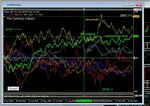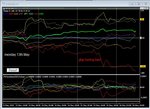I am confused about synthetic currency pairs.
Lets say my account is in dollars.
Lets say you 'neutralize' doller and buy GBPUSD and buy USDJPY
So by doing this trade whether at the same time with the same amount or at different times with the same amount once the second trade is entered you are effectively trading the synthetic pair gbpjpy and buying it according to some websites.
not exactly .....unless you calculate correctly you have to ensure you have bought the exact amount of similar units or ther will be a difference.........
However I don't agree because I have tried it and think that you are only exposed to the movement of gby as being in the one of eight currency pairs involving gbp so lets say 12.5% for argument's sake. Similarly, you are only exposed to jpy by 12.5% through the buying of usdjpy......... you also have to consider the secondary currency and the volatility of the pair in question....its exposure and volatility
However were you to directly buy gbpjpy without being in the 'legs' to have been 'in' gbpjpy synthetically you would only be exposed to the currencies through the currency pair itself and not through the volume ratio of being in those legs of pairs to be in the synthetic pair.
Therefore it is different to trade gbpjpy outright than to assume that because you bought usdjpy and gbpusd that you can monitor your performance by looking at the gbpjpy chart.
The only thing to actually consider is that you would be double exposed to open a gbpjpy buy should you already have a buy on gbpusd and usdjpy or that should you sell gbpjpy one would be contrasted in their direction on gbp and jpy but only indirectly.
This is assuming, of course, that each of the eight pairs that make up the sentiment of a currency direction has a weighted ratio to that sentiment based on volume or volatility - I think the strength index in this thread could be viewed as an example of this.
It is quite complicated what I am trying to explain but I think the idea that you can trade a pair synthetically is nonsense because it eliminates the concept of looking at price action of the trades you are in and confuses me to think you can watch a synthetic pair at any point in time to gauge accuracy of a forecast of price.
sorry at this point you have lost me ......theres nothing wrong with buying a basket of currencies across the GBP pairs if you like a direction of GBP.......you can do it on 3-4 pairs really to cover the odds...sure you could by all 7 of teh G8 pairs for gbp if yuo want to cover the odds ...but you have to be mindful of the ATR of each pair and weight accordingly
I think the idea of synthetic pairs is genuinely therefore for institutions who would actually need to transact in the synthetic currency but through the use of legs for whatever reason, swaps, forwards, etc and therefore has nothing to do with speculation whatsoever and that if my analysis above is right then it can only be empowering to know that if you neutralize your exposure to a currency and are indirectly exposed to a 'synthetic' pair you are only exposed as far as the legs have exposure and that by entering the pair itself you are increasing or decreasing the exposure but it is essentially exogenous to those other variables/legs of exposure in so far that to be exposed to the currency and not the pair, being in three pairs is three out of eight exposure to one out of eight exposure. hope that makes sense.
The same can be applied to sellign EURCHF and buying NZDCHF etc etc





